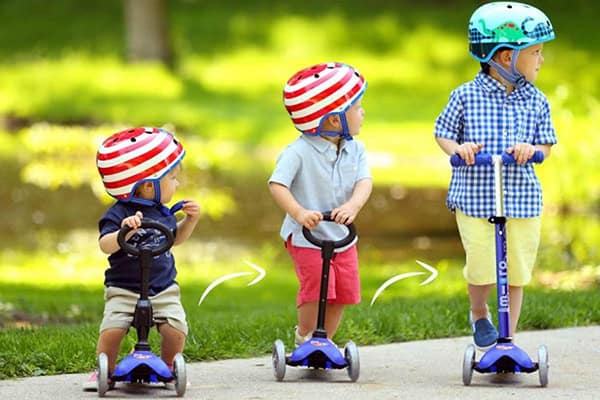Watching your child grow is one of the most fascinating journeys. Just like introducing them to a new toy, you might be excited about getting your little one their first scooter! But wait, do you know what age a child can ride a scooter?

2 to 3 years are considered to be the ideal age set for a child to ride a scooter by most parents & experts. However, these are not definitive age numbers as children’s physical development varies.
Don’t worry if you’re feeling lost already; I’ll help you determine the perfect age for your child to ride a scooter. That being said, let’s get started!
5 Important Factors To Consider Before Getting Your Child a Scooter
Scooter comes with greater risks compared to other toys your child is playing with. For the risk factors, it is crucial for parents like you to carefully select the correct timing for introducing a scooter.
To help you decide, I’ll discuss the top 5 factors to consider before getting your child a scooter. These are:
- Age & Motor Skills
- Physical Strength
- Balance & Coordination
- Willingness To Learn & Practice
- Prior Experience of Your Child
Contents
- 1. Age & Motor Skills: Is Your Child Above 2-3 Years or Not?
- 2. Physical Strength: Do Your Child Have Enough Physical Strength?
- 3. Balance & Coordination: Does Your Child Have The Ability of Balancing?
- 4. Willingness to Learn and Practice: Is Your Child Interested in Scooter?
- 5. Experience with Other Ride-On Toys: Have Your Child Tried Other Ride-on Toys?
- Final Conclusion
1. Age & Motor Skills: Is Your Child Above 2-3 Years or Not?
Every child’s development (both mental & physical) varies. Some might develop faster or slower than the majority & it’s totally fine. But, the rule of thumb is not to give a child a scooter if s/he is younger than 2 to 3 years.
During this period (2 to 3 years), children make significant strides in acquiring essential motor skills. Kids start to master the art of walking confidently by age 2. Later on, they can run & even jump!
If you’re noticing your kid to be joyful and active, it might indicate rewarding them with a scooter. Check the other four factors to ensure it is the time.
2. Physical Strength: Do Your Child Have Enough Physical Strength?
Only age & motor skills aren’t enough to determine whether or not a kid is suitable for a scooter. Physical strength is another big factor to consider for the following reasons:
- Leg Strength: Riding a scooter requires pushing off the ground with one foot and balancing the whole body on another foot at once. This whole pushing & balancing process requires a lot of leg strength.
- Upper Body Strength: Steering and maintaining the body balance is a tough job and requires solid upper body strength.
Kids don’t have to do dedicated workouts to gain physical strength, daily tiring activities are enough for them. Make sure your kid is active throughout the day and doing activities such as – nature walks, running, water play and picnics.
Regular indoor and outdoor activity can help improve bone health and help them gain enough strength to handle a scooter on their own.
3. Balance & Coordination: Does Your Child Have The Ability of Balancing?
Here are some of the methods you can try to determine whether or not your kid is capable of balancing a scooter:
- Walking on a Straight Line: Draw a line on the ground with chalk or tape. Now, ask your kid to walk along the line – placing one foot in front of the other, heel to toe. This test will help you to understand your kid’s balance and coordination.
- Balancing on One Foot: Ask your kid to lift one foot and stand on the other for around 3 seconds. Passing this test will also require a lot of physical strength – so it’s very important that your kid pass it for the scooter.
- Playing Catch: Throw a soft ball towards your kid and ask him to catch it. Throwing and catching activities enhance hand-eye coordination and reduce reaction time, which are essential for scooter riding.
Congratulations if your kid passes all these three tests – your kid has become impressively strong! Proceed to the remaining factors for more clarity.
4. Willingness to Learn and Practice: Is Your Child Interested in Scooter?
Apart from physical strength, your kid’s interest & willingness to ride also matters. Learning and riding a scooter isn’t a one-shot task; it takes constant practice and patience.
Failing the first couple of tries is normal. Like other kids, your kid must go through this failing phase. But, during the failing days – your kid will need intrinsic motivation to continue trying and getting better at riding.
5. Experience with Other Ride-On Toys: Have Your Child Tried Other Ride-on Toys?
There are many other ride-on toys that are comparatively safer than a scooter. Some of these safe ride-on toys are – tricycles, balance bikes and pedal cars. If your kid is already playing with one of these toys (or similar toys), it will be easier for them to be familiar with a scooter.
However, lacking experience with other ride-on toys doesn’t necessarily mean your child can’t ride a scooter. It means they will need more time to familiarize themselves with the necessary skills.
Final Conclusion
I hope you understand that choosing the right time for your child to start scooting isn’t just about age. Their physical growth, willingness to learn, and previous experience with similar activities play a vital role too.
If your child ticks all these boxes and you believe a scooter would enhance their physical development, go ahead and surprise them with one. But if your little one isn’t showing interest or doesn’t seem to want it, it’s best to hold off on the scooter for now.